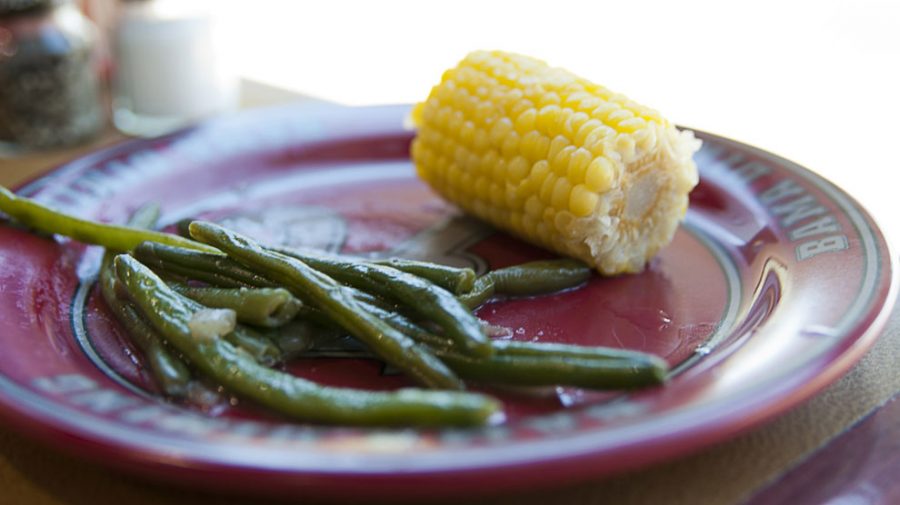It was just a quick bite between classes at Fresh Foods. First, I headed for the Southern Kitchen for some turkey leg, which came with carrots and brussels. Next door were some interesting-looking stuffed shells – maybe half of one wouldn’t hurt. I finished it off with a little soup and a side salad and grabbed another cookie for desert, but there was a warm, untouched batch of bread pudding that I couldn’t not sample.
I totaled up my light lunch. It came out to over 1300 calories. What?
According to Health Center dietician Sheena Quizon, it wasn’t the dining hall’s fault. “Healthy options are available,” she said.
These are some tips for eating well in the dining halls, which as I discovered, can be trickier than you think.
Don’t eat with your eyes
A range of options is great if you want to get the biggest bang for your swipe, but Quizon says variety can be dangerous for healthy eating. She tells her clients to resist the urge to sample everything they see, a habit she calls “eating with your eyes.”
She suggests taking a tour of the dining hall and getting an idea of what you want before you even pick up a plate. “If you’re going to indulge in something, at least you’re indulging in one thing.”
No, seriously, eat your vegetables
And not just a side salad. In fact, according to Quizon, your plate should contain non-starchy vegetables. They’re a great way to add substance to a meal without racking up the calories. Even the ones cooked in oil or butter rarely have over 100.
“Take advantage of nature’s fast food,” Quizon said.
The devil is in the details
Even if you cut on side items and pile your plate with greens, you’re not out of the woods yet. The extras – dressings, sauces, bacon bits, mayonnaise, etc. – can turn even the healthiest dish into a category four fat storm.
“You may get a salad, but it’s not really healthy when you pour gobs and gobs of dressing on top,” Quizon said.
In fact, just a half a cup of ranch could have as much trans-fat as a deep fried burrito. Try vinaigrette dressing and tomato-based pasta sauce instead of creamy and buttery choices.
It isn’t as lean as it looks
With names like “penne rosa” and “basil-pesto wrap,” vegetarian meals just sound healthier, but that isn’t always the case. Burke’s veggie burgers actually have more calories and sodium than their bovine counterparts, and while Lakeside’s pork burrito has 338 calories, the vegetarian burrito has 884 calories and a whopping 1766 milligrams of sodium.
“Sometimes they’ll have prepared wraps in Fresh Foods or Lakeside, but they’ll have a lot of mayonnaise and stuff,” Quizon said. “Half a sandwich and soup can be over a 1000 calorie meal.”
Don’t come hungry
It’s good to be a little peckish when you go out, but stuffing a full meal into a stomach that hasn’t eaten since the night before can switch the body from fat-burn to fat-gain mode.
“The body is thinking, ‘OK, this person hasn’t fed me at breakfast or lunch, so now I’m going to hold all this in,’” Quizon said.
Even worse, being ravenous at the buffet hypercharges the craving for foods rich in fat and sugar, meaning you’re more likely to ditch your plan to eat a grilled chicken sandwich when you smell that T-bone steak.
Don’t skip meals, and to take the edge off, try a light snack a half hour before you go out.
Nutrition facts and you
The nutrition facts come from a national company that provides the recipes and ingredients to all Bama Dining locations, but the individual dining halls tend to keep it loose. The batches can vary, and servers don’t always dole out the printed serving size, meaning it’s up to us to keep track of whether a breast and wing of barbecue chicken is actually “serving size: 4 oz.”
“But it’s a good ballpark,” Quizon said.
The nutrition cards are also handy for avoiding nutritional landmines, so you know when that handful of tortilla chips actually contains 1500 milligrams of sodium.
You can schedule a consulting session with the SHC Nutrition office by calling 348-2778.









